2017 Display Aircraft Update!
[vc_row padding_top=”0px” padding_bottom=”0px”][vc_column fade_animation_offset=”45px” width=”1/1″][text_output]
Insider – HUGE Ground Display Aircraft Update!
Last Update: 10/16/17 15:11 CT
As an Airshow Insider, we promised you the HUGE ground display aircraft update . . . FIRST! We will be going public with this shortly so be sure to check it out. In addition to the jaw-dropping USAF Thunderbirds, you will see some of the best civilian and military pilots in the world – flying for you. Plus, one of the largest displays of civilian & military aircraft in North America (75+ planes).
Important Note on the Warbird Display Ramp
Some aircraft below are on the WARBIRD DISPLAY RAMP. Display times will vary. If you’d like to see these aircraft … please arrive early! Below is your Insider peek into several notable aircraft you will be able to see this weekend, both on the ground and flying!
Please note: Aircraft below might not be the exact paint scheme shown. All display aircraft are subject to change without notice.
MH-53E Sea Dragon – U.S. Navy
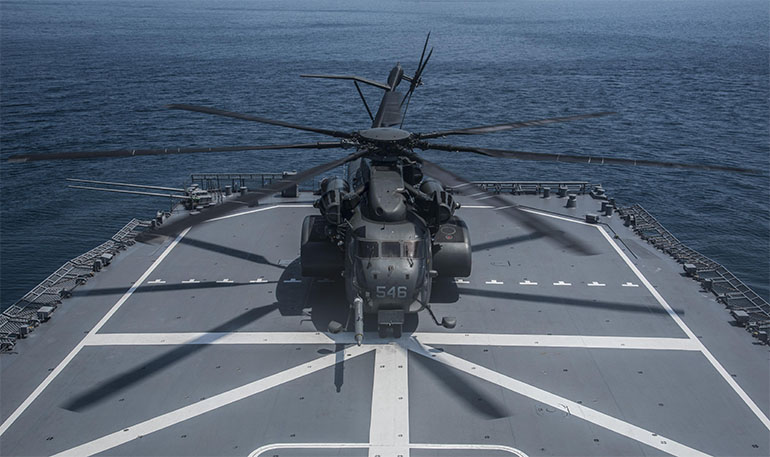
Description
The MH-53E is used primarily for Airborne Mine Countermeasures (AMCM), with secondary missions of vertical shipboard delivery and assault support. It incorporates Global Positioning System (GPS), Doppler radar, and an Approach/Hover/Tow Coupler. Communications include Ultra High Frequency (UHF)/ Very High Frequency (VHF)/ High Frequency (HF) radios, secure communications capability, and Identified Friend or Foe (IFF).
Features
The MH-53 can operate from carriers and other warships and is capable of towing a variety of mine hunting/sweeping countermeasures systems, including the Mk 105 magnetic mine-sweeping sled, the AQS-14A side-scan sonar, and the Mk 103 mechanical minesweeping system. When performing the assault support mission, the MH-53E can be fitted with the GAU-21 .50-cal. machine gun ramp-mounted weapon system.
Source:
http://www.navy.mil/navydata/
fact_display.asp?cid=1200&tid=400&ct=1
A-10 Thunderbolt II
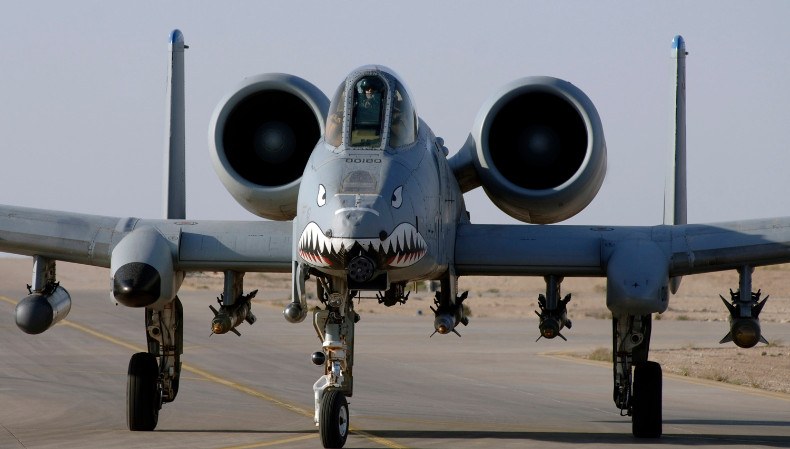
“The A-10 Thunderbolt II, also known as the Warthog, is a twin-engine aircraft that provides close-air support of ground forces and employs a wide variety of conventional munitions, including general purpose bombs. The simple, effective and survivable single-seat aircraft can be used against all ground targets, including tanks and other armored vehicles. The aircraft is currently supporting operations in Afghanistan and Iraq.”
Credit:
Boeing, http://www.boeing.com/boeing/defense-space/
support/maintenance/a10/index.page
F-16C Fighting Falcon
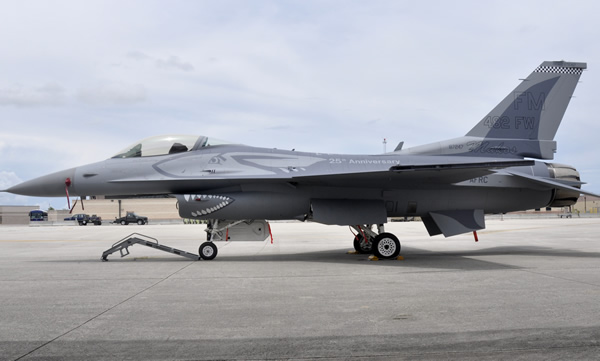
“The F-16 Fighting Falcon is a compact, multi-role fighter aircraft. It is highly maneuverable and has proven itself in air-to-air combat and air-to-surface attack. It provides a relatively low-cost, high-performance weapon system for the United States and allied nations. In an air combat role, the F-16’s maneuverability and combat radius (distance it can fly to enter air combat, stay, fight and return) exceed that of all potential threat fighter aircraft. It can locate targets in all weather conditions and detect low flying aircraft in radar ground clutter. In an air-to-surface role, the F-16 can fly more than 500 miles (860 kilometers), deliver its weapons with superior accuracy, defend itself against enemy aircraft, and return to its starting point. An all-weather capability allows it to accurately deliver ordnance during non-visual bombing conditions.”
Credit/Source:
http://www.af.mil/AboutUs/FactSheets/Display/
tabid/224/Article/104505/f-16-fighting-falcon.aspx
MH-65 Dolphin
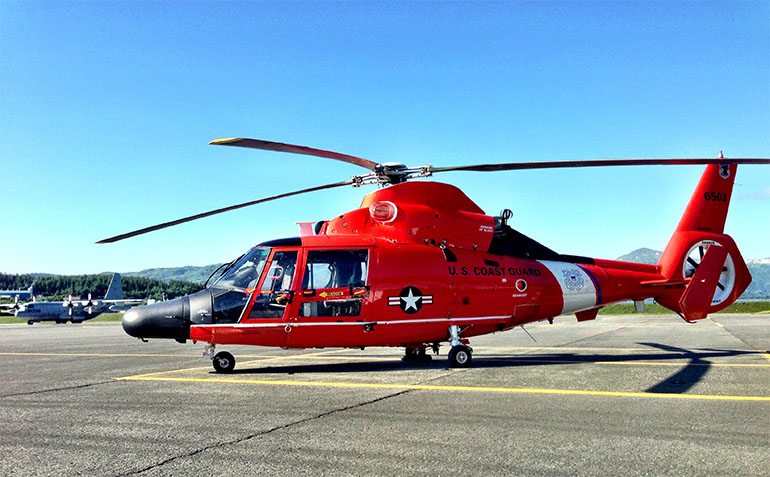
The SA366 G1 Dauphin version was selected by the United States Coast Guard in 1979 as its new short range recovery (SRR) air-sea rescue helicopter, replacing the Sikorsky HH-52A Sea Guard. In total 99 helicopters, optimised for the USCG’s search and rescue role tasks and given the designation HH-65A Dolphin, were acquired. Unlike the HH-52, the HH-65A is not able to perform water landings. The HH-65 normally carries a crew of four: Pilot, Copilot, Flight Mechanic and Rescue Swimmer.
The Dolphin was manufactured by Aerospatiale Helicopter Corporation (later American Eurocopter) in Grand Prairie, Texas. Textron Lycoming’s LTS101-750B-2 turboshaft engines were selected for the twin engine powerplant whilst Rockwell Collins manufactured the HH-65’s electronic systems in Cedar Rapids, Iowa.
The HH-65 Dolphin is used for homeland security patrols, cargo, drug interdiction, ice breaking, military readiness, pollution control, and search and rescue missions. The HH-65 is known for its Fenestron tail rotor and its autopilot capabilities, which can complete an unaided approach to the water and bring the aircraft into a stable 50 ft (15 m) hover, or automatically fly search patterns, an ability which allows the crew to engage in other tasks.
Source:
https://en.wikipedia.org/wiki/
Eurocopter_HH-65_Dolphin
F-15C Eagle
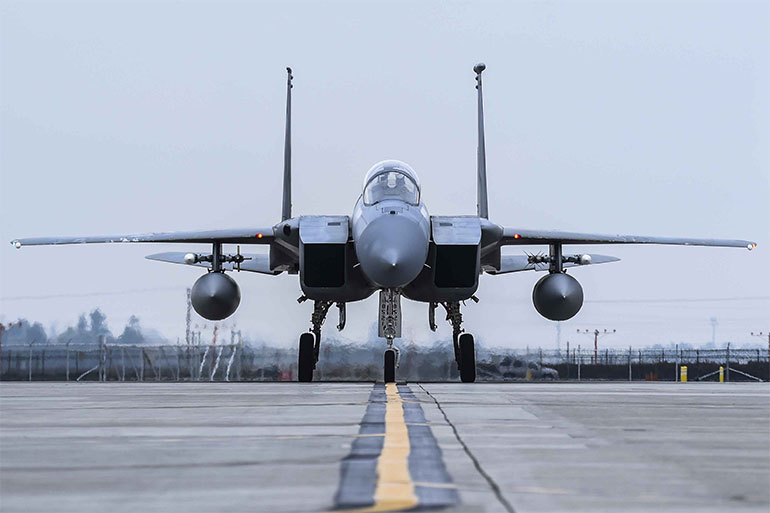 “The McDonnell Douglas F-15 Eagle is an American twin-engine, all-weather tactical fighter aircraft designed by McDonnell Douglas (now Boeing) to gain and maintain air supremacy in aerial combat. Following reviews of proposals, the United States Air Force selected McDonnell Douglas’ design in 1967 to meet the service’s need for a dedicated air superiority fighter. The Eagle first flew in July 1972, and entered service in 1976. It is among the most successful modern fighters, with over 100 victories and no losses in aerial combat, with the majority of the kills scored by the Israeli Air Force.
“The McDonnell Douglas F-15 Eagle is an American twin-engine, all-weather tactical fighter aircraft designed by McDonnell Douglas (now Boeing) to gain and maintain air supremacy in aerial combat. Following reviews of proposals, the United States Air Force selected McDonnell Douglas’ design in 1967 to meet the service’s need for a dedicated air superiority fighter. The Eagle first flew in July 1972, and entered service in 1976. It is among the most successful modern fighters, with over 100 victories and no losses in aerial combat, with the majority of the kills scored by the Israeli Air Force.
The Eagle has been exported to Israel, Japan, and Saudi Arabia. The F-15 was originally envisioned as a pure air superiority aircraft. Its design included a secondary ground-attack capability that was largely unused. The aircraft design proved flexible enough that an all-weather strike derivative, the F-15E Strike Eagle, an improved and enhanced version, which was later developed entered service in 1989 and exported to several nations. As of 2017, the aircraft is being produced in different variants with production line set to end in 2022, 50 years after the type’s first flight.”
Photo / Info Credit:
https://en.wikipedia.org/wiki/
McDonnell_Douglas_F-15_Eagle
WC-130J Hercules “Hurricane Hunter” – Kessler AFB
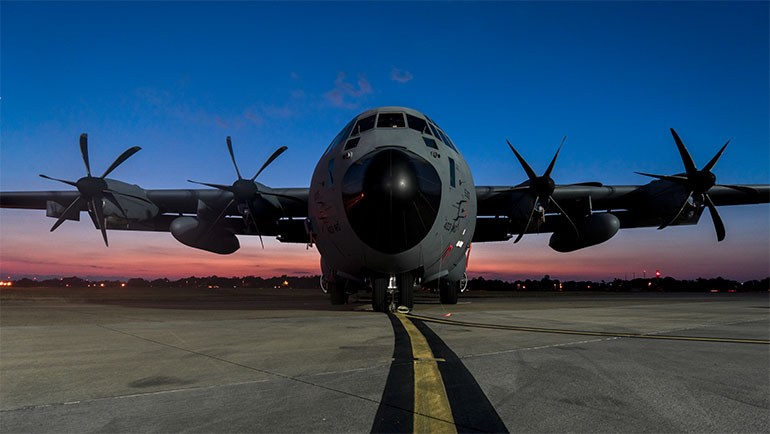
Mission
The WC-130 Hercules is a high-wing, medium-range aircraft flown by the Air Force Reserve Command for weather reconnaissance missions. The aircraft penetrates tropical disturbances and storms, hurricanes and winter storms to obtain data on movement, size and intensity. The WC-130J is the weather data collection platform for the 53rd Weather Reconnaissance Squadron located at Keesler Air Force Base, Miss.
Features
The WC-130J is a C-130J transport configured with palletized weather instrumentation that collects weather data, and is capable of staying aloft almost 18 hours at an optimum cruise speed of more than 300 mph.
The WC-130 provides vital tropical cyclone forecasting information. It penetrates tropical cyclones and hurricanes at altitudes ranging from 500 to 10,000 feet (151.7 to 3,033.3 meters) above the ocean surface depending upon the intensity of the storm.
An average weather reconnaissance mission might last 11 hours and cover almost 3,500 miles while the crew collects and reports weather data. The WC-130J carries a minimal crew of five: pilot, co-pilot, navigator, aerial reconnaissance weather officer and weather reconnaissance loadmaster.
Photo / Info Credit:
http://www.af.mil/About-Us/Fact-Sheets/
Display/Article/104561/wc-130-hercules/
UH-60 Black Hawk
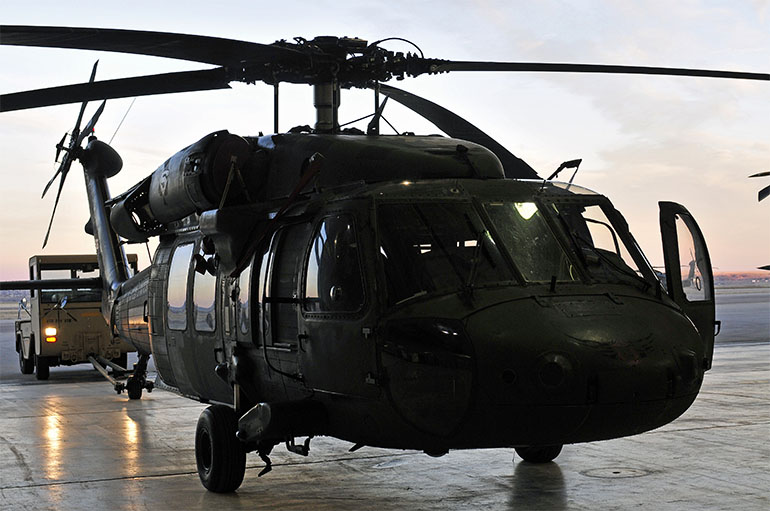 “The Sikorsky UH-60 Black Hawk is a four-bladed, twin-engine, medium-lift utility helicopter manufactured by Sikorsky Aircraft. Sikorsky submitted the S-70 design for the United States Army’s Utility Tactical Transport Aircraft System (UTTAS) competition in 1972. The Army designated the prototype as the YUH-60A and selected the Black Hawk as the winner of the program in 1976, after a fly-off competition with the Boeing Vertol YUH-61.
“The Sikorsky UH-60 Black Hawk is a four-bladed, twin-engine, medium-lift utility helicopter manufactured by Sikorsky Aircraft. Sikorsky submitted the S-70 design for the United States Army’s Utility Tactical Transport Aircraft System (UTTAS) competition in 1972. The Army designated the prototype as the YUH-60A and selected the Black Hawk as the winner of the program in 1976, after a fly-off competition with the Boeing Vertol YUH-61.
Named after the Native American war leader Black Hawk, the UH-60A entered service with the U.S. Army in 1979, to replace the Bell UH-1 Iroquois as the Army’s tactical transport helicopter. This was followed by the fielding of electronic warfare and special operations variants of the Black Hawk. Improved UH-60L and UH-60M utility variants have also been developed. Modified versions have also been developed for the U.S. Navy, Air Force, and Coast Guard. In addition to U.S. Army use, the UH-60 family has been exported to several nations. Black Hawks have served in combat during conflicts in Grenada, Panama, Iraq, Somalia, the Balkans, Afghanistan, and other areas in the Middle East.
After entering service, the helicopter was modified for new missions and roles, including mine laying and medical evacuation. An EH-60 variant was developed to conduct electronic warfare and special operations aviation developed the MH-60 variant to support its missions.”
Photo / Info Credit:
https://en.wikipedia.org/wiki/
Sikorsky_UH-60_Black_Hawk
B-52 Stratofortress . . . “BUFF!”
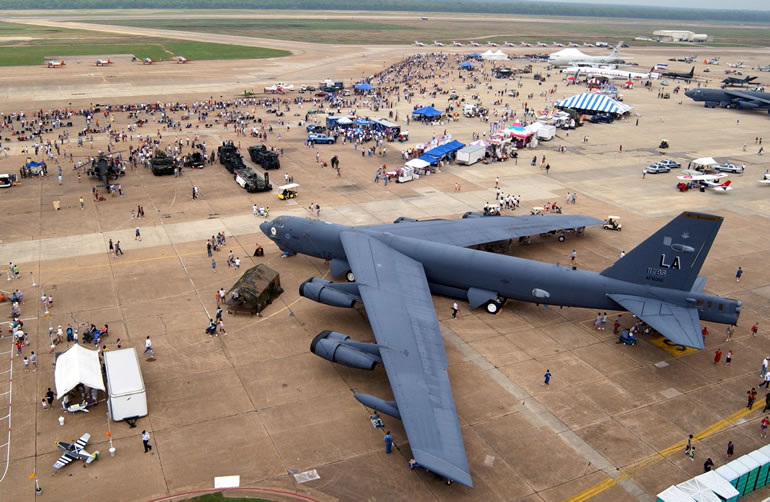
“The B-52 is a long-range, heavy bomber that can perform a variety of missions. The bomber is capable of flying at high subsonic speeds at altitudes up to 50,000 feet (15,166.6 meters). It can carry nuclear or precision guided conventional ordnance with worldwide precision navigation capability.”
Source/Link:
http://www.af.mil/AboutUs/FactSheets/Display/
tabid/224/Article/104465/b-52-stratofortress.aspx
MQ-9 Reaper
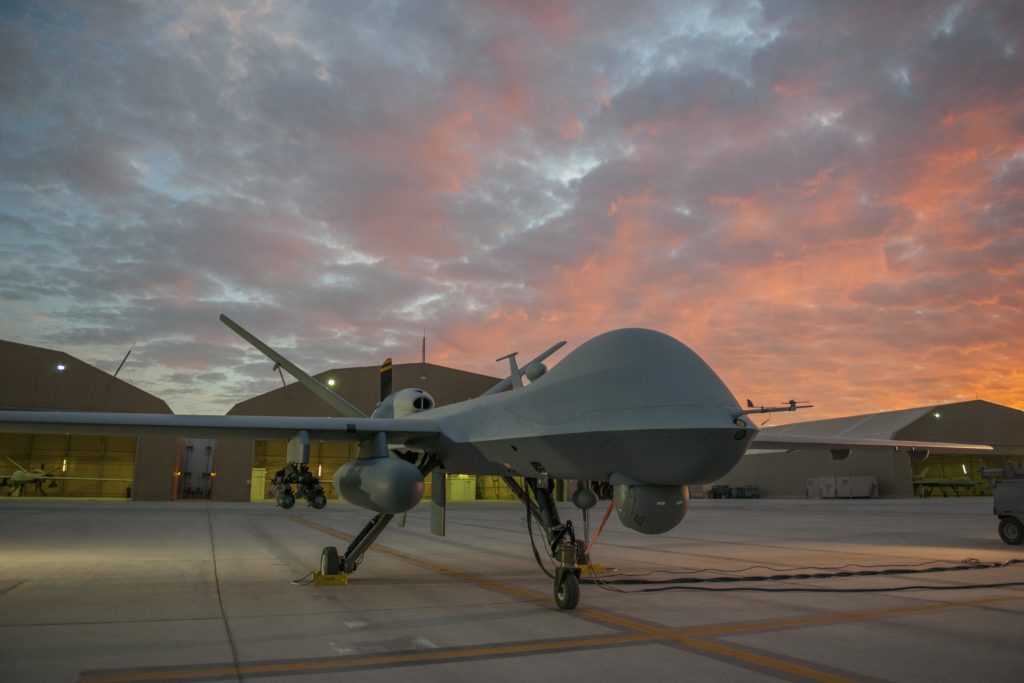
Mission against dynamic execution targets and secondarily as an intelligence collection asset. Given its significant loiter time, wide-range sensors, multi-mode communications suite, and precision weapons — it provides a unique capability to perform strike, coordination, and reconnaissance against high-value, fleeting, and time-sensitive targets.
Reapers can also perform the following missions and tasks: intelligence, surveillance, reconnaissance, close air support, combat search and rescue, precision strike, buddy-lase, convoy/raid overwatch, target development, and terminal air guidance. The MQ-9’s capabilities make it uniquely qualified to conduct irregular warfare operations in support of combatant commander objectives.
Credit/Source:
http://www.af.mil/About-Us/Fact-Sheets/
Display/Article/104470/mq-9-reaper/
AH-64 Apache
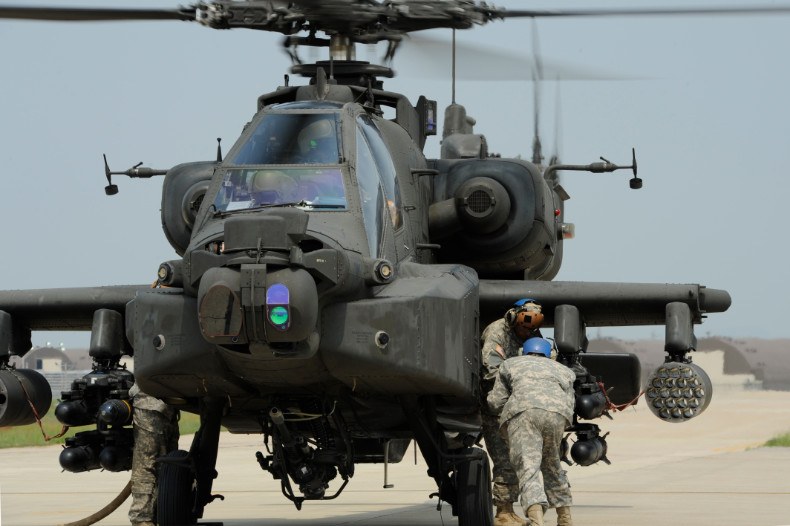
The Boeing AH-64 Apache is an American four-blade, twin-turboshaft attack helicopter with a tailwheel-type landing gear arrangement and a tandem cockpit for a two-man crew. It features a nose-mounted sensor suite for target acquisition and night vision systems. It is armed with a 30 mm (1.18 in) M230 chain gun carried between the main landing gear, under the aircraft’s forward fuselage. It has four hardpoints mounted on stub-wing pylons, typically carrying a mixture of AGM-114 Hellfire missiles and Hydra 70 rocket pods. The AH-64 has a large amount of systems redundancy to improve combat survivability.
The U.S. Army is the primary operator of the AH-64; it has also become the primary attack helicopter of multiple nations, including Greece, Japan, Israel, the Netherlands, Singapore, and the United Arab Emirates; as well as being produced under license in the United Kingdom as the AgustaWestland Apache. American AH-64s have served in conflicts in Panama, the Persian Gulf, Kosovo, Afghanistan, and Iraq. Israel used the Apache in its military conflicts in Lebanon and the Gaza Strip; British and Dutch Apaches have seen deployments in wars in Afghanistan and Iraq.
Credit/Source:
https://en.wikipedia.org/wiki/
Boeing_AH-64_Apache
HC-130 Hercules
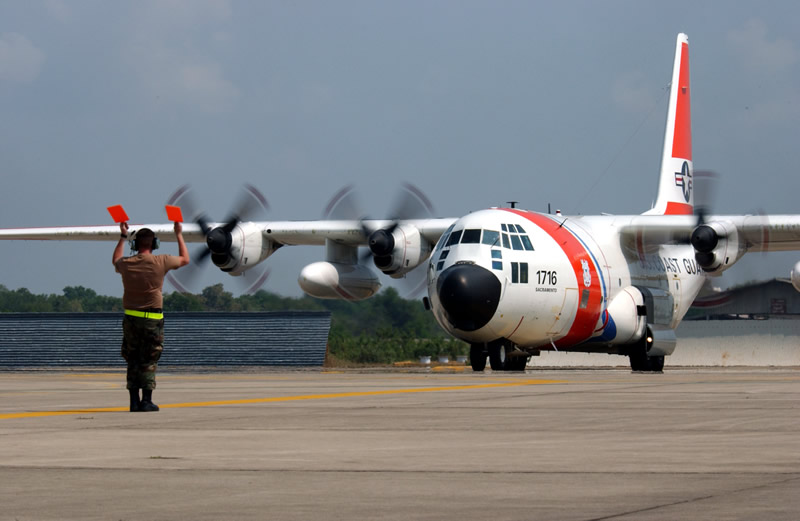
“The Lockheed HC-130 is an extended-range, search and rescue (SAR)/combat search and rescue (CSAR) version of the C-130 Hercules transport, with two different versions operated by two separate services in the U.S. armed forces.The HC-130H Hercules and HC-130J Hercules versions are operated by the United States Coast Guard in a SAR and maritime reconnaissance role.
U.S. Coast Guard HC-130Hs were primarily acquired for long-range overwater search missions, support airlift, maritime patrol, North Atlantic Ice Patrol and command and control of search and rescue, replacing previously operated HU-16 Albatross amphibious and HC-123 Provider land-based aircraft. Like their USAF counterparts, USCG HC-130s also have the capability of air dropping rescue equipment to survivors at sea or over open terrain.
The new HC-130J aircraft are derived from the Lockheed Martin KC-130J tanker operated by the U.S. Marine Corps. The USCG has six HC-130Js in service, but they are not capable of refueling helicopters in flight. The first delivery of this variant to the United States Coast Guard was in October 2003. They initially operated in a logistic support role until they received significant modifications, including installations of a large window on each side of the fuselage to allow crew members to visually scan the sea surface, the addition of an inverse synthetic aperture sea search radar, flare tubes, a forward-looking infrared/electro-optical sensor, a gaseous oxygen system for the crew and an enhanced communications suite. The first of these modified Coast Guard HC-130Js was delivered in March 2008.”
HC-130 Copy Credit/Source:
https://en.wikipedia.org/wiki/Lockheed_HC-130
NASA T-38 Talon
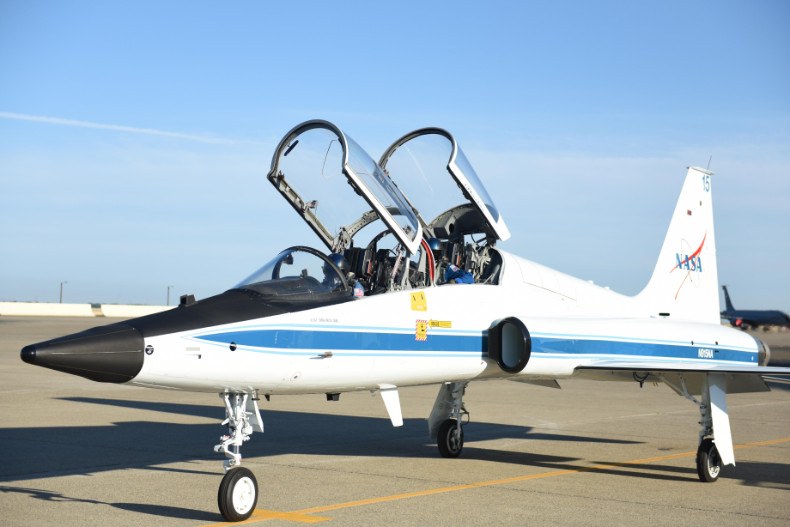
“The T-38 Talon is a twin-engine, high-altitude, supersonic jet trainer used in a variety of roles because of its design, economy of operations, ease of maintenance, high performance and exceptional safety record. Air Education and Training Command is the primary user of the T-38 for joint specialized undergraduate pilot training. Air Combat Command, Air Force Materiel Command and the National Aeronautics and Space Administration also use the T-38A in various roles.”
Copy Credit/Source:
http://www.af.mil/AboutUs/FactSheets/
Display/tabid/224/Article/104569/t-38-talon.aspx
AH-1 Cobra
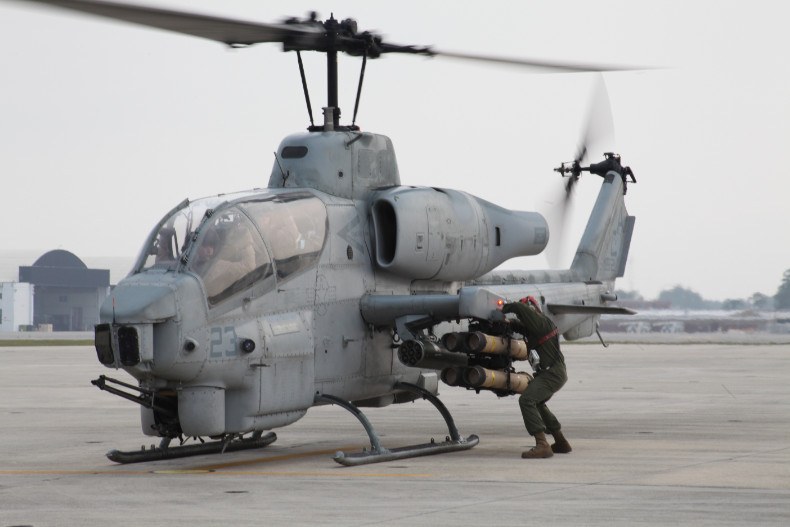
“The Bell AH-1 Cobra is a two-blade, single engine attack helicopter manufactured by Bell Helicopter. It was developed using the engine, transmission and rotor system of the Bell UH-1 Iroquois. A member of the prolific Huey family, the AH-1 is also referred to as the HueyCobra or Snake.
The AH-1 was the backbone of the United States Army’s attack helicopter fleet, but has been replaced by the AH-64 Apache in Army service. Upgraded versions continue to fly with the militaries of several other nations. The AH-1 twin engine versions remain in service with United States Marine Corps (USMC) as the service’s primary attack helicopter. Surplus AH-1 helicopters have been converted for fighting forest fires.”
Credit:
https://en.wikipedia.org/wiki/
Bell_AH-1_Cobra
MiG-21 Fishbed
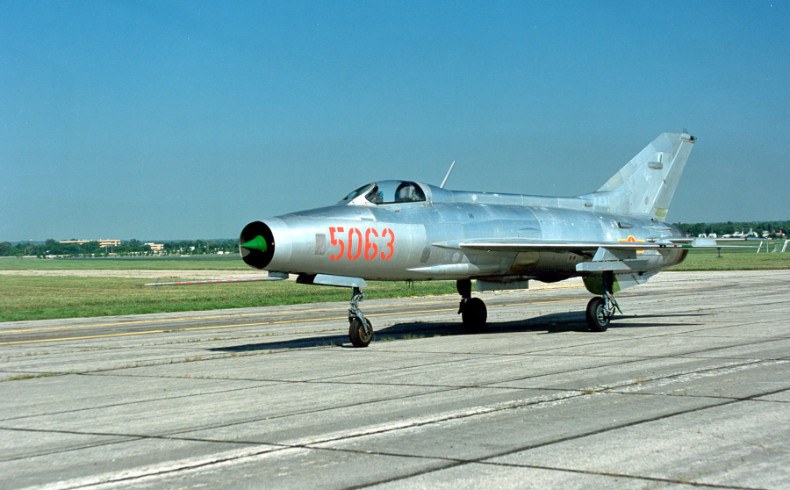
“The Mikoyan-Gurevich MiG-21 (Russian: Микоян и Гуревич МиГ-21; NATO reporting name: Fishbed) is a supersonic jet fighter aircraft, designed by the Mikoyan-Gurevich Design Bureau in the Soviet Union. It was popularly nicknamed “Balalaika”, from the aircraft’s planform-view resemblance to the Russian stringed musical instrument or ołówek (English: pencil) by Polish pilots due to the shape of its fuselage.
Early versions are considered second-generation jet fighters, while later versions are considered to be third-generation jet fighters.[citation needed] Approximately 60 countries over four continents have flown the MiG-21, and it still serves many nations six decades after its maiden flight. The fighter made aviation records. At least by name, it is the most-produced supersonic jet aircraft in aviation history and the most-produced combat aircraft since the Korean War, and it was previously the longest production run of a combat aircraft (now exceeded by both the McDonnell Douglas F-15 Eagle and General Dynamics F-16 Fighting Falcon).”
Credit:
https://en.wikipedia.org/wiki/
Mikoyan-Gurevich_MiG-21
MiG-17 Fresco
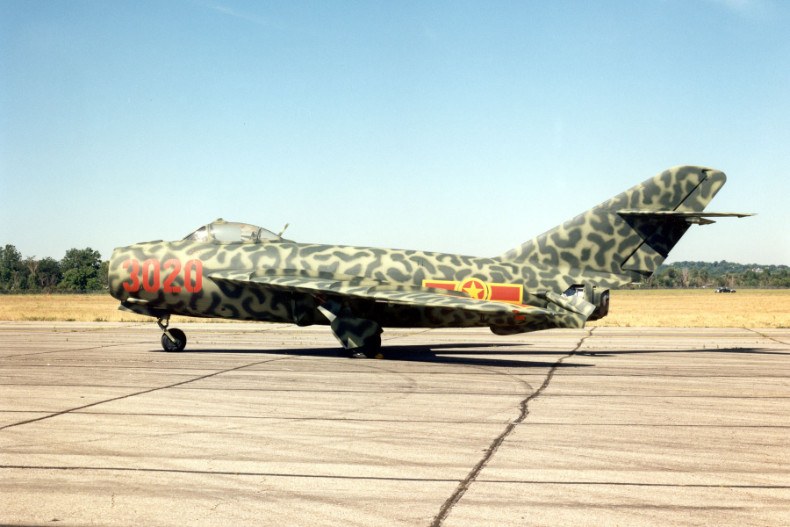
“The Mikoyan-Gurevich MiG-17 (Russian: Микоян и Гуревич МиГ-17) (NATO reporting name: Fresco) (China:Shenyang J-5) (Poland: PZL-Mielec Lim-5)[1] is a high-subsonic fighter aircraft produced in the USSR from 1952 and operated by numerous air forces in many variants. It is an advanced development of the very similar appearing MiG-15 of the Korean War.
The MiG-17 first saw combat in 1958 over the Straits of Taiwan and was used as an effective threat against supersonic fighters of the United States in the Vietnam War. It was also briefly known as the Type 38, by U.S. Air Force designation prior to the development of NATO codes.
Source/Credit:
https://en.wikipedia.org/wiki/
Mikoyan-Gurevich_MiG-17
UH-1 Iroquois
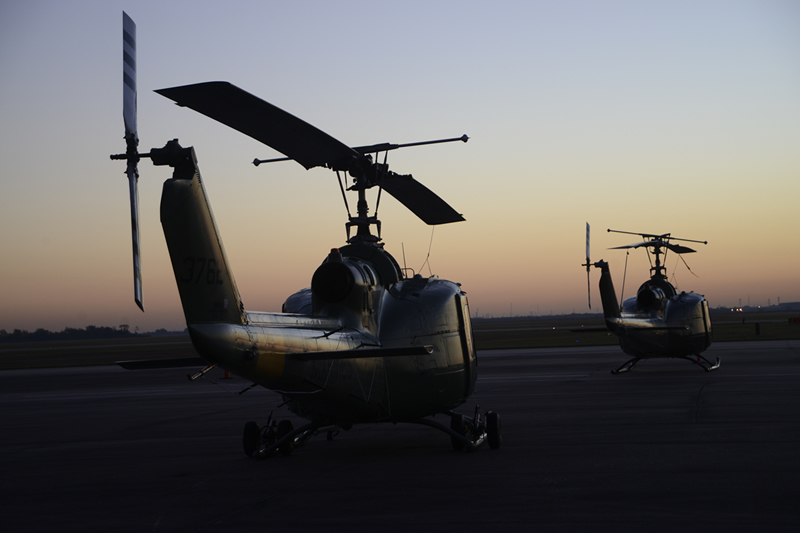
The Bell UH-1 Iroquois (nicknamed “Huey”) is a military helicopter powered by a single turboshaft engine, with two-blade main and tail rotors. The first member of the prolific Huey family, it was developed by Bell Helicopter to meet a United States Army’s 1952 requirement for a medical evacuation and utility helicopter, and first flew in 1956. The UH-1 was the first turbine-powered helicopter to enter production for the United States military, in 1960, and more than 16,000 have since been built.
The Iroquois was originally designated HU-1, hence the Huey nickname, which has remained in common use, despite the official redesignation to UH-1 in 1962.[2] The UH-1 first saw service in combat operations during the Vietnam War, with around 7,000 helicopters deployed. The Bell 204 and 205 are Iroquois versions developed for the civil market.
Source/Credit:
https://en.wikipedia.org/wiki/
Bell_UH-1_Iroquois
HU-16 Albatross
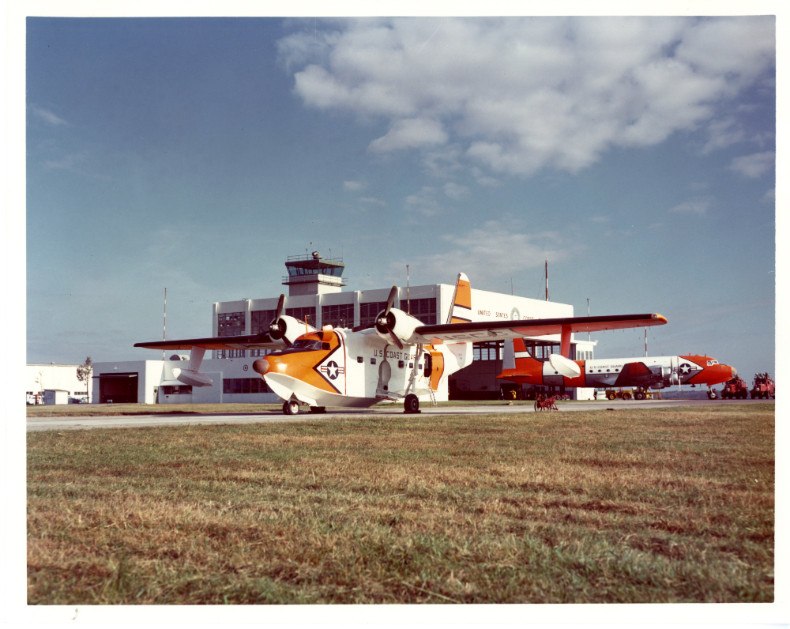
The Grumman HU-16 Albatross is a large twin–radial engine amphibious flying boat that was used by the United States Air Force (USAF), the U.S. Navy (USN) and the U.S. Coast Guard (USCG), primarily as a search and rescue aircraft. Originally designated as the SA-16 for the USAF and the JR2F-1 and UF-1 for the USN and USCG, it was redesignated as the HU-16 in 1962.
Source/Credit:
https://en.wikipedia.org/wiki/
Grumman_HU-16_Albatross
BT-13 Valiant
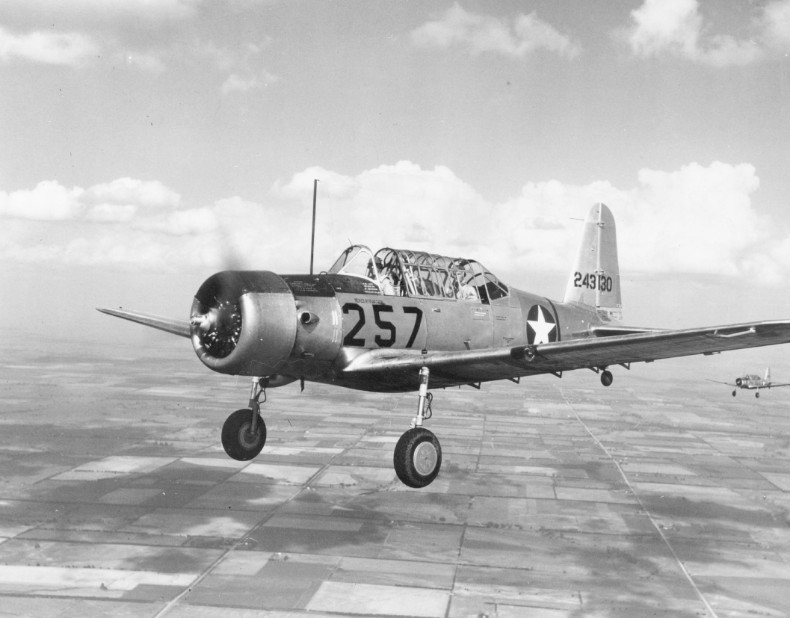
The Vultee BT-13 Valiant was an American World War II-era basic trainer aircraft built by Vultee Aircraft for the United States Army Air Corps, and later US Army Air Forces. A subsequent variant of the BT-13 in USAAC/USAAF service was known as the BT-15 Valiant, while an identical version for the US Navy was known as the SNV and was used to train naval aviators for the US Navy and its sister services, the US Marine Corps and US Coast Guard.
Source/Credit:
https://en.wikipedia.org/wiki/
Vultee_BT-13_Valiant
Naval Aircraft Factory N3N
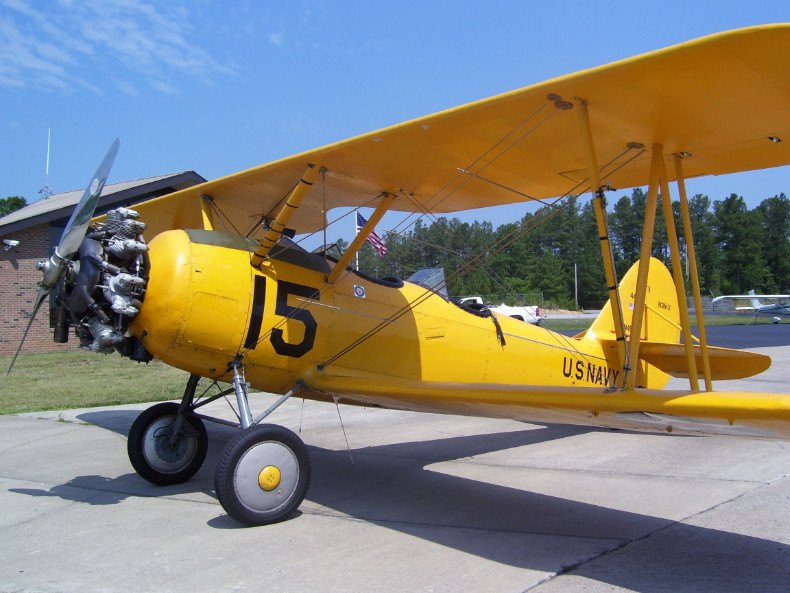
The Naval Aircraft Factory N3N was an American tandem-seat, open cockpit, primary training biplane aircraft built by the Naval Aircraft Factory (NAF) in Philadelphia, Pennsylvania, during the 1930s.
Source/Credit:
https://en.wikipedia.org/wiki/
Naval_Aircraft_Factory_N3N
Fairchild PT-19
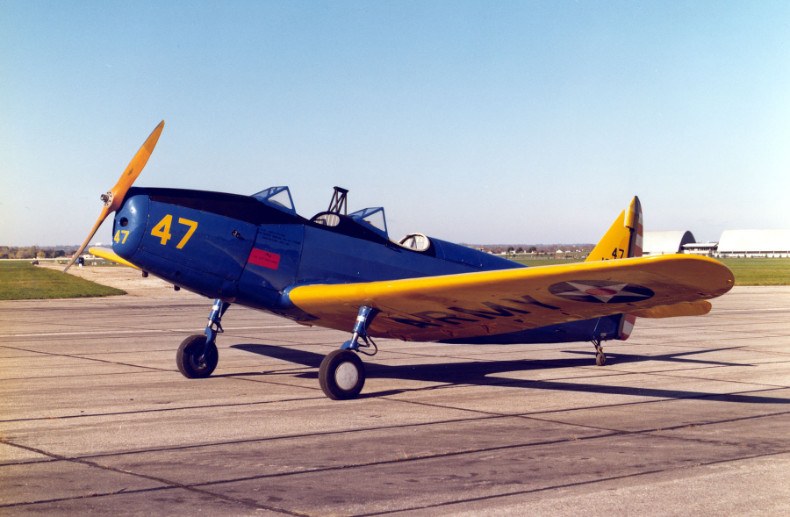
“The Fairchild PT-19 (company designation Fairchild M62) is an American Fairchild Aircraft monoplane primary trainer aircraft that served with the United States Army Air Forces, RAF and RCAF during World War II. It was a contemporary of the Kaydet biplane trainer and was used by the USAAF during Primary Flying Training as the introductory pre-solo phase trainer for introducing new pilots to flying before passing them on to the more agile Kaydet. As with other USAAF trainers of the period, the PT-19 had multiple designations based on the powerplant installed.”
Source/Credit:
https://en.wikipedia.org/wiki/
Fairchild_PT-19
T-6G Texan
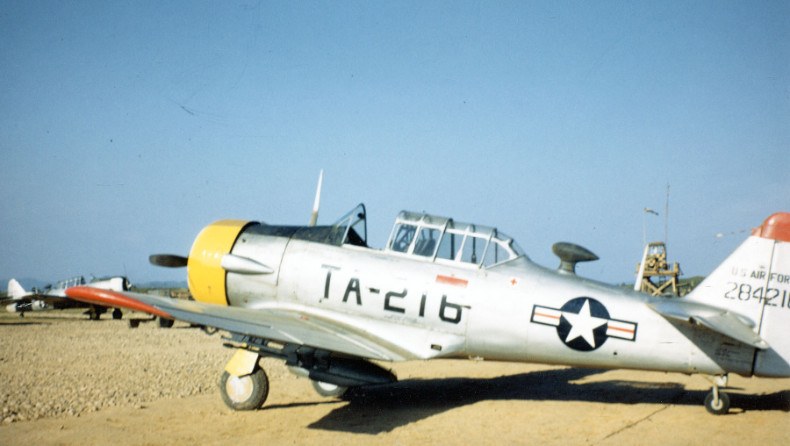
“The North American Aviation T-6 Texan is a single-engined advanced trainer aircraft used to train pilots of the United States Army Air Forces (USAAF), United States Navy, Royal Air Force, and other air forces of the British Commonwealth during World War II and into the 1970s. Designed by North American Aviation, the T-6 is known by a variety of designations depending on the model and operating air force. The United States Army Air Corps (USAAC) and USAAF designated it as the AT-6, the United States Navy the SNJ, and British Commonwealth air forces, the Harvard, the name by which it is best known outside of the US. After 1962, US forces designated it the T-6. It remains a popular warbird aircraft used for airshow demonstrations and static displays. It has also been used many times to simulate various Japanese aircraft, including the Mitsubishi A6M Zero in movies depicting World War II in the Pacific.”
Source/Credit:
https://en.wikipedia.org/wiki/
North_American_T-6_Texan
C-45 Expeditor
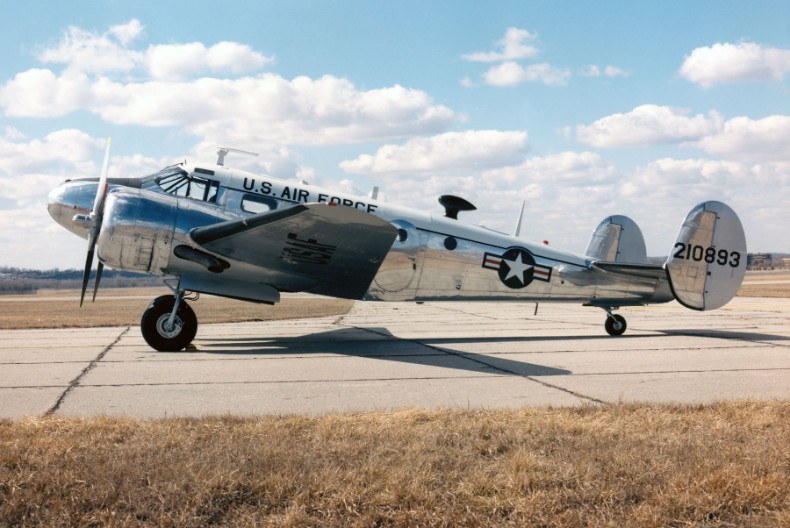
“The Beechcraft Model 18 (or “Twin Beech”, as it is also known) is a six to 11-seat, twin-engined, low-wing, tailwheel light aircraft manufactured by the Beech Aircraft Corporation of Wichita, Kansas. Continuously produced from 1937 to November 1969 (over 32 years, the world record at the time), over 9,000 were produced, making it one of the world’s most widely used light aircraft. Sold worldwide as a civilian executive, utility, cargo aircraft, and passenger airliner on tailwheels, nosewheels, skis or floats, it was also used as a military aircraft.
During and after World War II, over 4,500 Beech 18s saw military service—as light transport, light bomber (for China), aircrew trainer (for bombing, navigation and gunnery), photo-reconnaisance, and “mother ship” for target drones—including United States Army Air Forces (USAAF) C-45 Expeditor, AT-7 Navigator, AT-11 Kansan; and United States Navy (USN) UC-45J Navigator, SNB-1 Kansan, and others. In World War II, over 90% of USAAF bombardiers and navigators trained in these aircraft.
In the early postwar era, the Beech 18 was the pre-eminent “business aircraft” and “feeder airliner.” Besides carrying passengers, its civilian uses have included aerial spraying, sterile insect release, fish seeding, dry ice cloud seeding, aerial firefighting, air mail delivery, ambulance service, numerous movie productions, skydiving, freight, weapon- and drug-smuggling, engine testbed, skywriting, banner towing, and stunt aircraft. Many are now privately owned, around the world, with over 300 in the U.S. still on the FAA Aircraft Registry in December 2014″
Credit/Source:
https://en.wikipedia.org/wiki/
Beechcraft_Model_18
B-17G Flying Fortress
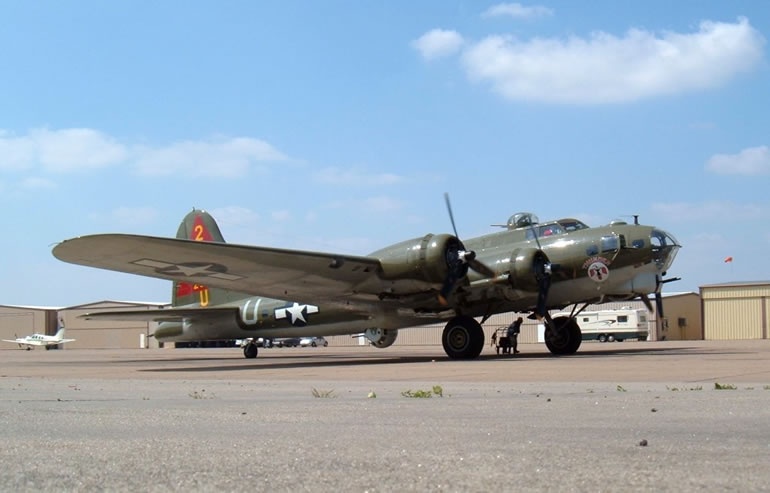
“The Boeing B-17 Flying Fortress is a four-engine heavy bomber developed in the 1930s for the United States Army Air Corps (USAAC). Competing against Douglas and Martin for a contract to build 200 bombers, the Boeing entry outperformed both competitors and exceeded the air corps’ performance specifications. Although Boeing lost the contract because the prototype crashed, the air corps ordered 13 more B-17s for further evaluation. From its introduction in 1938, the B-17 Flying Fortress evolved through numerous design advances.
The B-17 was primarily employed by the United States Army Air Forces (USAAF) in the daylight strategic bombing campaign of World War II against German industrial and military targets. The United States Eighth Air Force, based at many airfields in central and southern England, and the Fifteenth Air Force, based in Italy, complemented the RAF Bomber Command’s nighttime area bombing in the Combined Bomber Offensive to help secure air superiority over the cities, factories and battlefields of Western Europe in preparation for the invasion of France in 1944. The B-17 also participated to a lesser extent in the War in the Pacific, early in World War II, where it conducted raids against Japanese shipping and airfields.
From its prewar inception, the USAAC (by June 1941, the USAAF) promoted the aircraft as a strategic weapon; it was a relatively fast, high-flying, long-range bomber with heavy defensive armament at the expense of bombload. It developed a reputation for toughness based upon stories and photos of badly-damaged B-17s safely returning to base. The B-17 developed a reputation as an effective bomber, dropping more bombs than any other U.S. aircraft in World War II. Of the 1.5 million tonnes of bombs dropped on Germany and its occupied territories by U.S. aircraft, 640,000 tonnes were dropped from B-17s. In addition to its role as a bomber, the B-17 was also employed as a transport, antisubmarine aircraft, drone controller, and search-and-rescue aircraft.
As of May 2015, ten aircraft remain airworthy. None of them are combat veterans. Dozens more are in storage or on static display. The oldest of these is a D-series veteran of combat in the Pacific and the Caribbean.”
Credit/Source:
https://en.wikipedia.org/wiki/
Boeing_B-17_Flying_Fortress
SBD Dauntless
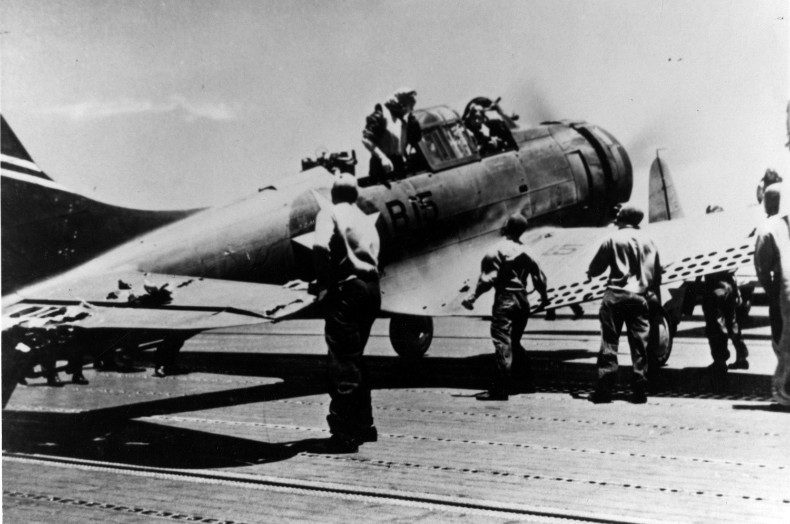
“The Douglas SBD Dauntless was a World War II American naval scout plane and dive bomber that was manufactured by Douglas Aircraft from 1940 through 1944. The SBD (“Scout Bomber Douglas”) was the United States Navy’s main carrier-borne scout plane and dive bomber from mid-1940 through mid-1944. The SBD was also flown by the United States Marine Corps, both from land air bases and aircraft carriers. The SBD is best remembered as the bomber that delivered the fatal blows to the Japanese carriers at the Battle of Midway in June 1942.
During its combat service, the SBD was an excellent naval scout plane and dive bomber. It possessed long range, good handling characteristics, maneuverability, potent bomb load, great diving characteristics, good defensive armament and ruggedness. One land-based variant of the SBD — in omitting the arrestor hook — was purpose-built for the U.S. Army Air Forces, as the A-24 Banshee.”
Credit/Source:
https://en.wikipedia.org/wiki/
Douglas_SBD_Dauntless
PT-17 Stearman
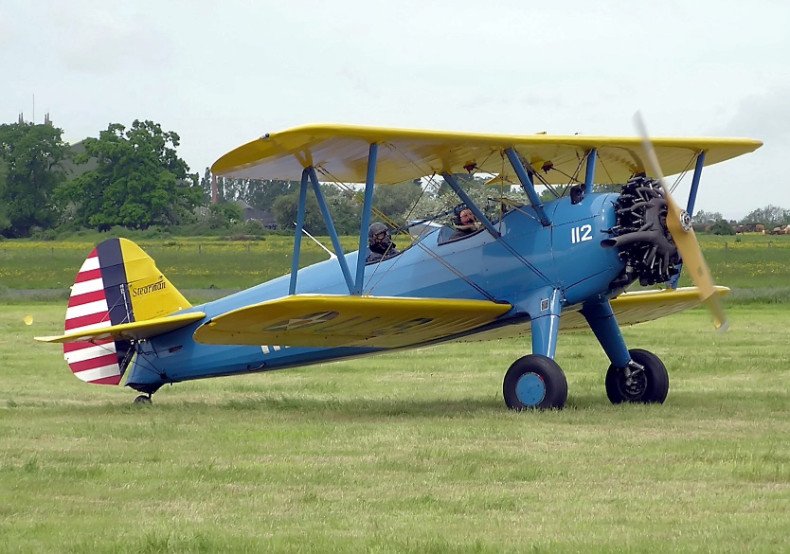
“The Stearman (Boeing) Model 75 is a biplane used as a military trainer aircraft, of which at least 10,626 were built in the United States during the 1930s and 1940s.[1] Stearman Aircraft became a subsidiary of Boeing in 1934. Widely known as the Stearman, Boeing Stearman or Kaydet, it served as a primary trainer for the United States Army Air Forces, the United States Navy (as the NS & N2S), and with the Royal Canadian Air Force as the Kaydet throughout World War II. After the conflict was over, thousands of surplus aircraft were sold on the civilian market. In the immediate postwar years they became popular as crop dusters, sports planes, and for aerobatic and wing walking use in air shows.”
Credit/Source:
https://en.wikipedia.org/wiki/
Boeing-Stearman_Model_75
P-47 Thunderbolt
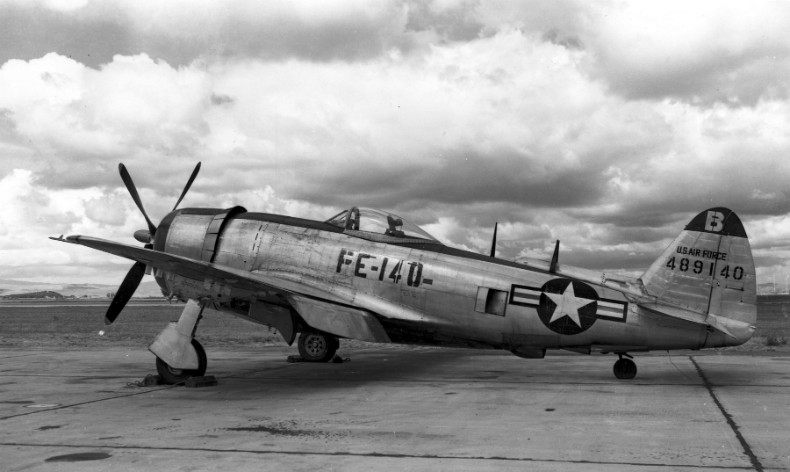
“The Republic P-47 Thunderbolt was a World War II era fighter aircraft produced by the United States between 1941–1945. Its primary armament was eight .50-caliber machine guns and in the fighter-bomber ground-attack role it could carry five-inch rockets or a bomb load of 2,500 pounds (1,103 kg), more than half the payload of the Boeing B-17 Flying Fortress bomber. When fully loaded the P-47 weighed up to eight tons (tonnes) making it one of the heaviest fighters of the war. The P-47 was designed around the powerful Pratt & Whitney R-2800 Double Wasp engine which was also used by two U.S. Navy fighters, the Grumman F6F Hellcat and the Vought F4U Corsair. The Thunderbolt was effective as a short-to-medium range escort fighter in high-altitude air-to-air combat and ground attack in both the World War II European and Pacific theaters.
The P-47 was one of the main United States Army Air Forces (USAAF) fighters of World War II, and served with Allied air forces including France, Britain, and Russia. Mexican and Brazilian squadrons fighting alongside the U.S. were equipped with the P-47.
The armored cockpit was relatively roomy and comfortable, offering good visibility. A modern-day U.S. ground-attack aircraft, the Fairchild Republic A-10 Thunderbolt II, takes its name from the P-47.”
Credit/Source:
https://en.wikipedia.org/wiki/
Republic_P-47_Thunderbolt
T-41 Mescalero
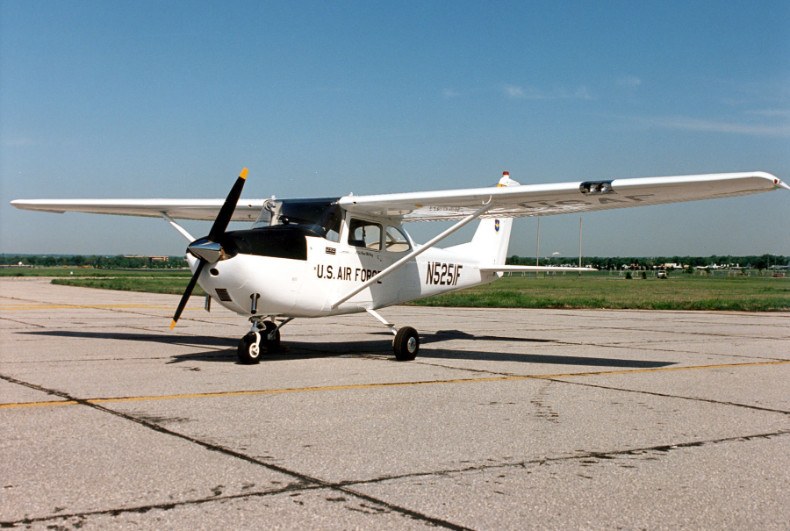
“The Cessna T-41 Mescalero is a military version of the popular Cessna 172, operated by the United States Air Force and Army as well as the armed forces of various other countries as a pilot training aircraft.”
Credit/Source:
https://en.wikipedia.org/wiki/
Cessna_T-41_Mescalero
A-26 Invader
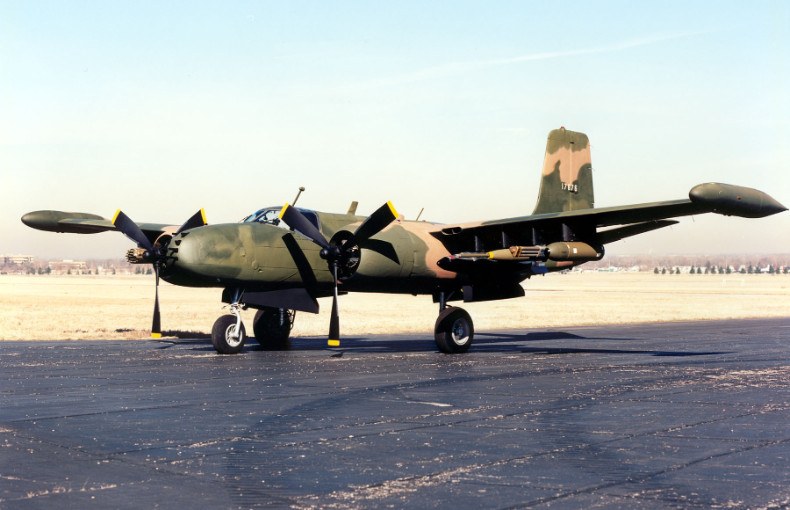
“The Douglas A-26 Invader (designated B-26 between 1948 and 1965) is a twin-engined light bomber and ground attack aircraft that was built by Douglas Aircraft Company during World War II which also saw service during several major Cold War conflicts. A limited number of highly modified United States Air Force aircraft served in Southeast Asia until 1969. It was a fast aircraft capable of carrying twice its specified bomb load. A range of guns could be fitted to produce a formidable ground-attack aircraft.”
Credit/Source:
https://en.wikipedia.org/wiki/
Douglas_A-26_Invader
A-1D Skyraider
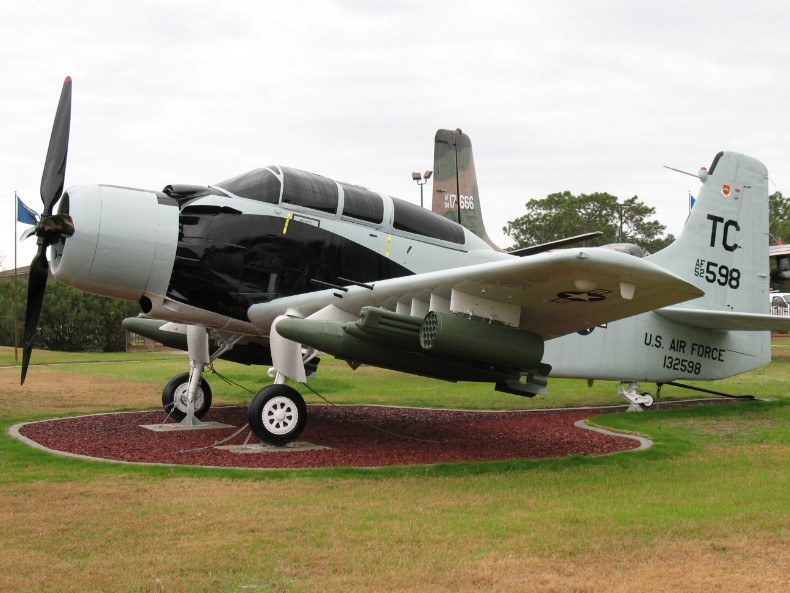
“The Douglas A-1 Skyraider (formerly AD) is an American single-seat attack aircraft that saw service between the late 1940s and early 1980s. The Skyraider had a remarkably long and successful career; it became a piston-powered, propeller-driven anachronism in the jet age, and was nicknamed “Spad”, after the French World War I fighter.
It was operated by the United States Navy (USN), the United States Marine Corps (USMC) and the United States Air Force (USAF), and also saw service with the British Royal Navy, the French Air Force, the Air Force of the Republic of Vietnam (VNAF), and others. In U.S. service, it was finally replaced by the LTV A-7 Corsair II swept wing subsonic jet in the early 1970s.”
Credit/Source:
https://en.wikipedia.org/wiki/Douglas_A-1_Skyraider
F6F Hellcat
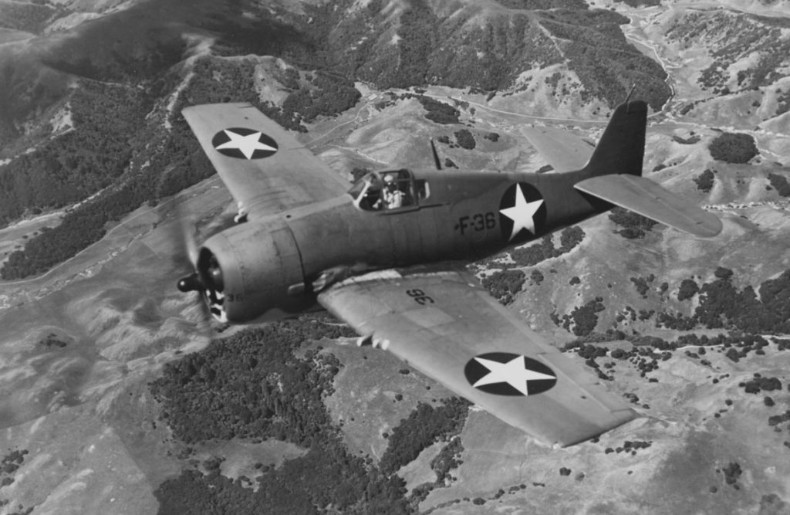
“The Grumman F6F Hellcat is an American carrier-based fighter aircraft designed to replace the earlier F4F Wildcat in United States Navy (USN) service. The Hellcat competed with the faster Vought F4U Corsair for use as a carrier based fighter. The Corsair had significant issues with carrier landings which the Hellcat did not, allowing the Hellcat to become the Navy’s dominant fighter in the second part of World War II, a position the Hellcat did not relinquish. The Corsair instead was primarily deployed to great effect in land-based use by the U.S. Marine Corps.
Although the F6F resembled the Wildcat in some ways, it was an entirely new design, powered by a 2,000 hp Pratt & Whitney R-2800, the same powerplant used for both the Corsair and the United States Army Air Force (USAAF) Republic P-47 Thunderbolt fighters. Some military observers tagged the Hellcat as the “Wildcat’s big brother”.
The F6F was best known for its role as a rugged, well-designed carrier fighter which was able, after its combat debut in early 1943, to counter the Mitsubishi A6M Zero and help secure air superiority over the Pacific Theater. Such was the quality of the basic simple, straightforward design, that 12,200 were built in just over two years.
Hellcats were credited with destroying a total of 5,223 enemy aircraft while in service with the U.S. Navy, U.S. Marine Corps and the Royal Navy Fleet Air Arm. This was more than any other Allied naval aircraft. Postwar, the Hellcat was phased out of front line service but remained in service as late as 1954 as a night fighter.”
Credit/Source:
https://en.wikipedia.org/wiki/
Grumman_F6F_Hellcat
PT-22 Recruit
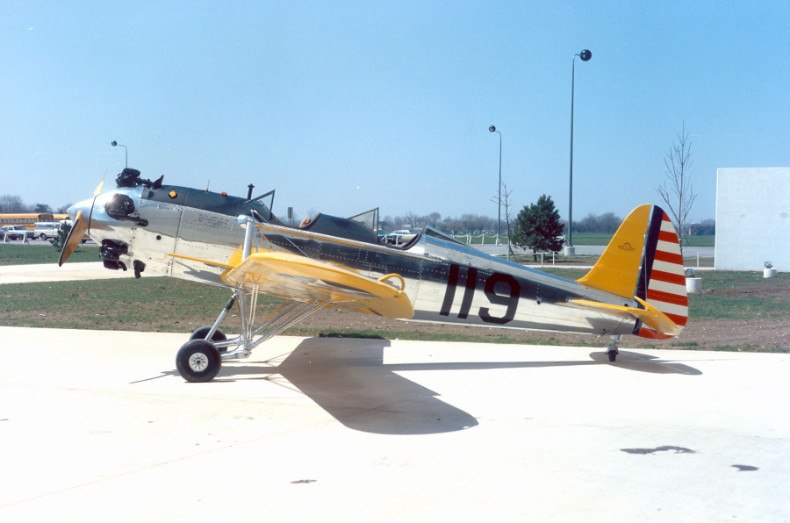
“The PT-22 was developed in 1941 from the civilian Ryan ST series. The earlier PT-20 and PT-21 were the military production versions of the Ryan ST-3 with a total of 100 built. The PT-22 was the United States Army Air Corps’ first purpose built monoplane trainer. The rapid expansion of wartime aircrew training required new trainers, and the Ryan PT-22 was ordered in large numbers. Named the “Recruit”, it entered operational service with the U.S. Orders also were placed by the Netherlands, but were never realized as the nation capitulated to Axis forces. The small order of 25 ST-3s was redirected to the United States and redesignated as the PT-22A. Another order also came from the U.S. Navy for 100 examples. The PT series was in heavy use throughout the war years with both military and civil schools, but with the end of the war, was retired from the U.S.A.A.F.”
Credit/Source:
https://en.wikipedia.org/wiki/
Ryan_PT-22_Recruit
O-2 Skymaster
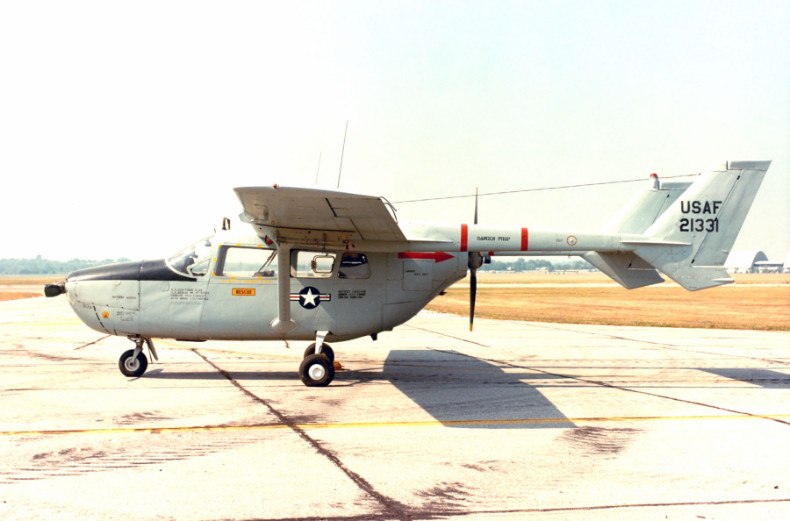
“The Cessna O-2 Skymaster (nicknamed “Oscar Deuce”) is a military version of the Cessna 337 Super Skymaster, used for forward air control (FAC) and psychological operations (PSYOPS) by the US military between 1967 and 2010.
In 1966 the United States Air Force (USAF) commissioned Cessna to build a military variant to replace the O-1 Bird Dog and the O-2 resulted.”
Credit/Source:
https://en.wikipedia.org/wiki/
Cessna_O-2_Skymaster
L-19/O-1 Bird Dog
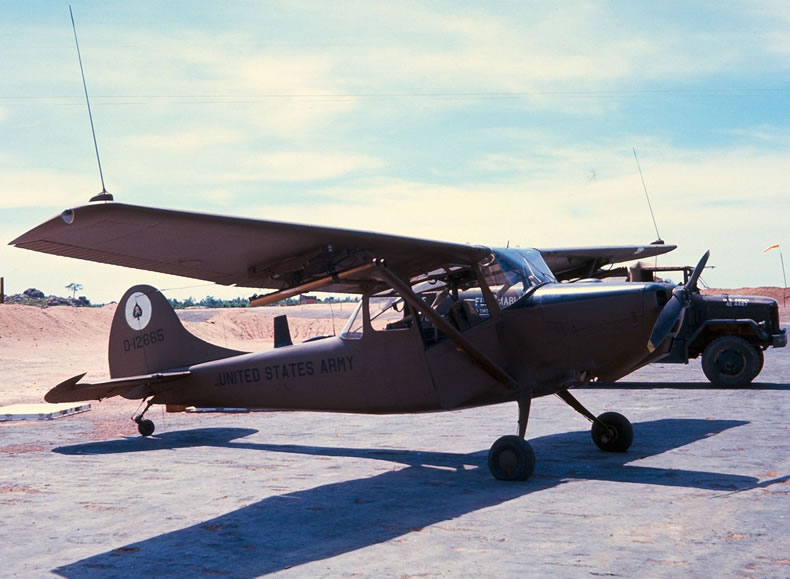
“The Cessna L-19/O-1 Bird Dog was a liaison and observation aircraft. It was the first all-metal fixed-wing aircraft ordered for and by the United States Army since the U.S. Army Air Forces separated from the Army in 1947, becoming its own branch of service, the United States Air Force. The Bird Dog had a lengthy career in the U.S. military, as well as in other countries.”
Credit/Source:
https://en.wikipedia.org/wiki/
Cessna_O-1_Bird_Dog
SB2C Helldiver
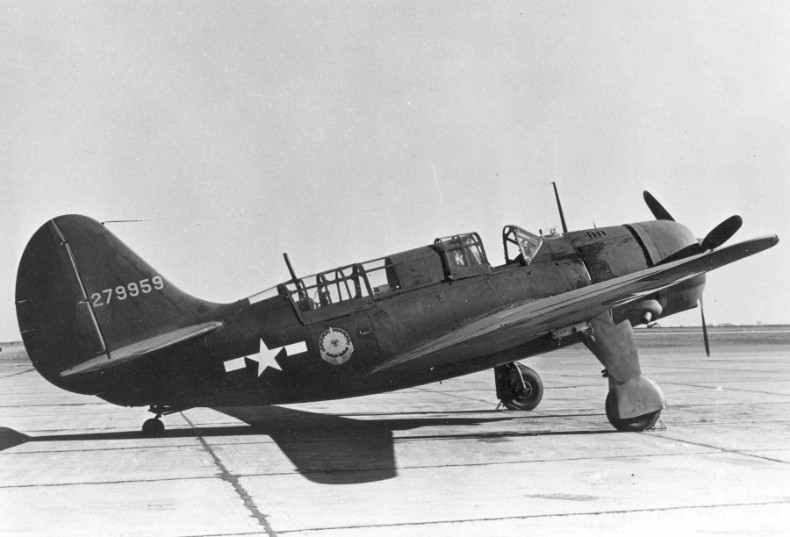
“The Curtiss SB2C Helldiver was a carrier-based dive bomber aircraft produced for the United States Navy during World War II. It replaced the Douglas SBD Dauntless in US Navy service. The SB2C was much faster than the SBD it replaced.
Crew nicknames for the aircraft included the Big-Tailed Beast (or just the derogatory Beast), Two-Cee and Son-of-a-Bitch 2nd Class (after its designation and partly because of its reputation for having difficult handling characteristics). Neither pilots nor aircraft carrier captains seemed to like it.
Delays marred its production—by the time the A-25 Shrike variant for the USAAF was deployed in late 1943, the Army Air Forces no longer had a need for a thoroughbred dive bomber. Poor handling of the aircraft was another factor that hampered its service introductions; both the British Royal Navy and the Royal Australian Air Force cancelled substantial orders.
The Truman Committee investigated Helldiver production and turned in a scathing report, which eventually led to the beginning of the end for Curtiss. Problems with the Helldiver were eventually ironed out, and in spite of its early problems, the aircraft was flown through the last two years of the Pacific War with a fine combat record.”
Credit/Source:
https://en.wikipedia.org/wiki/
Curtiss_SB2C_Helldiver
P-63 Kingcobra
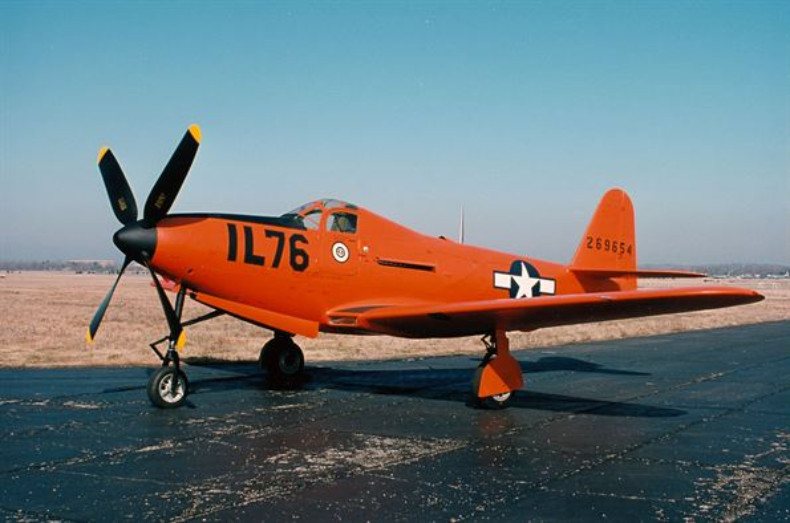
“The Bell P-63 Kingcobra is an American fighter aircraft developed by Bell Aircraft in World War II from the Bell P-39 Airacobra in an attempt to correct that aircraft’s deficiencies. Although the P-63 was not accepted for combat use by the United States Army Air Forces, it was successfully adopted by the Soviet Air Force.”
Source/Link:
https://en.wikipedia.org/wiki/
Bell_P-63_Kingcobra
Messerschmitt Me 262 “Swallow”
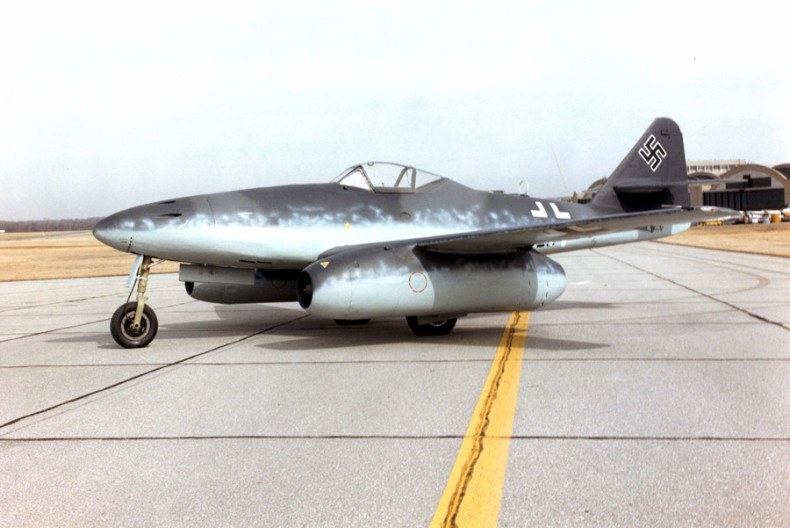
“The Messerschmitt Me 262, nicknamed Schwalbe (German: “Swallow”) in fighter versions, or Sturmvogel (German: “Storm Bird”) in fighter-bomber versions, was the world’s first operational jet-powered fighter aircraft. Design work started before World War II began, but engine problems, metallurgical problems and top-level interference kept the aircraft from operational status with the Luftwaffe until mid-1944. The Me 262 was faster, and more heavily armed than any Allied fighter, including the British jet-powered Gloster Meteor. One of the most advanced aviation designs in operational use during World War II, the Me 262 was used roles including light bomber, reconnaissance and experimental night fighter versions.
Me 262 pilots claimed a total of 542 Allied kills, although higher claims are sometimes made.The Allies countered its potential effectiveness in the air by attacking the aircraft on the ground and during takeoff and landing. Engine reliability problems, from the pioneering nature of its Junkers Jumo 004 axial-flow turbojet engines—the first ever placed in mass production—and attacks by Allied forces on fuel supplies during the deteriorating late-war situation also reduced the effectiveness of the aircraft as a fighting force. In the end, the Me 262 had a negligible impact on the course of the war as a result of its late introduction and the consequently small numbers put in operational service.
While German use of the aircraft ended with the close of the Second World War, a small number were operated by the Czechoslovak Air Force until 1951. Captured Me 262s were studied and flight tested by the major powers, and ultimately influenced the designs of a number of post-war aircraft such as the North American F-86 Sabre and Boeing B-47 Stratojet. A number of aircraft have survived on static display in museums, and there have also been several privately built flying reproductions.”
Source/Link:
https://en.wikipedia.org/wiki/
Messerschmitt_Me_262
F4U Corsair
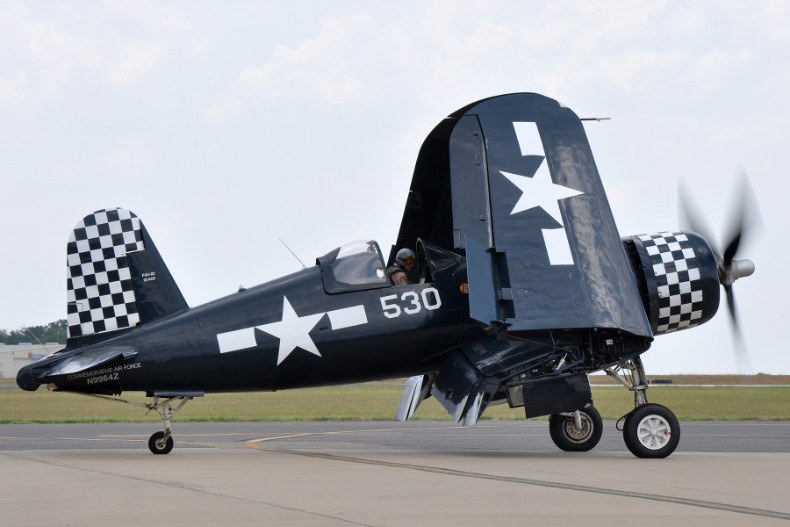
“The Vought F4U Corsair is an American fighter aircraft that saw service primarily in World War II and the Korean War. Demand for the aircraft soon overwhelmed Vought’s manufacturing capability, resulting in production by Goodyear and Brewster: Goodyear-built Corsairs were designated FG and Brewster-built aircraft F3A. From the first prototype delivery to the U.S. Navy in 1940, to final delivery in 1953 to the French, 12,571 F4U Corsairs were manufactured, in 16 separate models, in the longest production run of any piston-engined fighter in U.S. history (1942–53).
The Corsair was designed as a carrier-based aircraft but its difficult carrier landing performance rendered it unsuitable for Navy use until the carrier landing issues were overcome by the British Fleet Air Arm. The Corsair thus came to and retained prominence in its area of greatest deployment: land based use by the U.S. Marines. The role of the dominant U.S. carrier based fighter in the second part of the war was thus filled by the Grumman F6F Hellcat, powered by the same Double Wasp engine first flown on the Corsair’s first prototype in 1940. The Corsair served to a lesser degree in the U.S. Navy. As well as the U.S. and British use the Corsair was also used by the Royal New Zealand Air Force, the French Navy Aéronavale and other, smaller, air forces until the 1960s. Some Japanese pilots regarded it as the most formidable American fighter of World War II, and the U.S. Navy counted an 11:1 kill ratio with the F4U Corsair.”
Source/Link:
https://en.wikipedia.org/wiki/
Vought_F4U_Corsair
P-51 Mustang
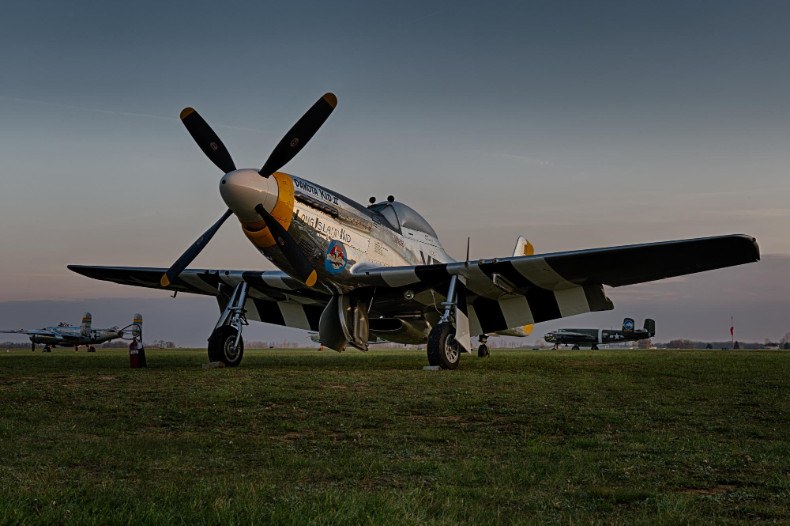
“The North American Aviation P-51 Mustang is an American long-range, single-seat fighter and fighter-bomber used during World War II, the Korean War and other conflicts. The Mustang was designed in 1940 by North American Aviation (NAA) in response to a requirement of the British Purchasing Commission for license-built Curtiss P-40 fighters. The prototype NA-73X airframe was rolled out on 9 September 1940, 102 days after the contract was signed and first flew on 26 October.
The Mustang was originally designed to use the Allison V-1710 engine, which, in its earlier variants, had limited high-altitude performance. It was first flown operationally by the Royal Air Force (RAF) as a tactical-reconnaissance aircraft and fighter-bomber (Mustang Mk I). The addition of the Rolls-Royce Merlin to the P-51B/C model transformed the Mustang’s performance at altitudes above 15,000 ft, matching or bettering that of the Luftwaffe’s fighters. The definitive version, the P-51D, was powered by the Packard V-1650-7, a license-built version of the Rolls-Royce Merlin 66 two-stage two-speed supercharged engine, and was armed with six .50 caliber (12.7 mm) M2/AN Browning machine guns.
From late 1943, P-51Bs (supplemented by P-51Ds from mid-1944) were used by the USAAF’s Eighth Air Force to escort bombers in raids over Germany, while the RAF’s 2 TAF and the USAAF’s Ninth Air Force used the Merlin-powered Mustangs as fighter-bombers, roles in which the Mustang helped ensure Allied air superiority in 1944.[10] The P-51 was also used by Allied air forces in the North African, Mediterranean and Italian theaters, and also served against the Japanese in the Pacific War. During World War II, Mustang pilots claimed 4,950 enemy aircraft shot down.
At the start of the Korean War, the Mustang was the main fighter of the United Nations until jet fighters such as the F-86 took over this role; the Mustang then became a specialized fighter-bomber. Despite the advent of jet fighters, the Mustang remained in service with some air forces until the early 1980s. After World War II and the Korean War, many Mustangs were converted for civilian use, especially air racing, and increasingly, preserved and flown as historic warbird aircraft at airshows.”
Credit/Source:
https://en.wikipedia.org/wiki/
North_American_P-51_Mustang
B-25 Mitchell
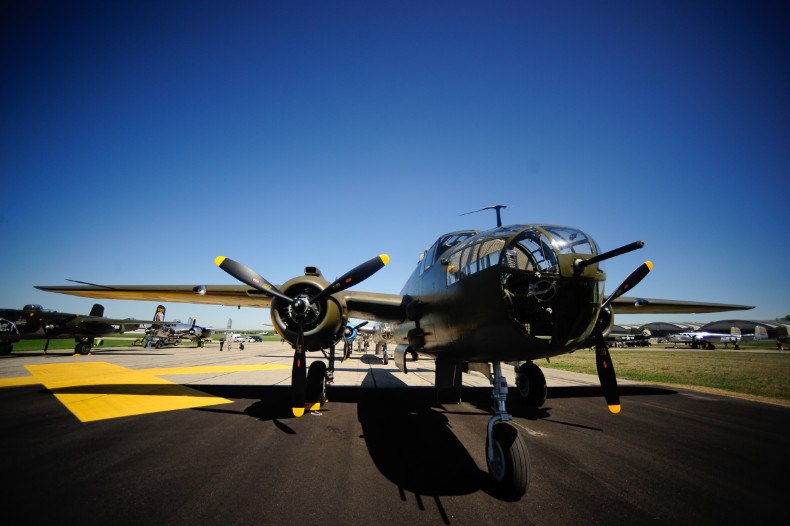
“The B-25 medium bomber was one of America’s most famous airplanes of World War II. It was the type used by Gen. Jimmy Doolittle for the Tokyo Raid on April 18, 1942.Subsequently, B-25s saw duty in every combat area being flown by the Dutch, British, Chinese, Russians and Australians in addition to U.S. forces. Although the airplane was originally intended for level bombing from medium altitudes, it was used extensively in the Pacific Theater for bombing Japanese airfields and beach emplacements from treetop level, and for strafing and skip bombing enemy shipping.Built by North American Aviation, the B-25 first flew on Aug. 19, 1940, and the U.S. Army Air Corps accepted the first five B-25s in February 1941. By the end of the war, North American Aviation had built a total of 9,816 B-25s at its California and Kansas plants.”
Source/Credit:
http://www.nationalmuseum.af.mil/Visit/
MuseumExhibits/FactSheets/Display/
tabid/509/Article/196310/north-american-b-25b-mitchell.aspx
Please note: Aircraft ABOVE might not be the exact model, type, or paint scheme shown. All display aircraft are subject to change without notice.
Only 5 Days LEFT – Have You Secured Your Up to 25% OFF Tickets Yet?
You can still SAVE on airshow tickets by clicking on the link below. This up to 25% OFF* Insider ONLY discount expire next Friday, October 20th at 11:59 P.M. CT. After that, prices go up. Make sure you secure your spot and SAVE.
Just click below, your Insider ONLY discount has been automatically applied …
[/text_output][/vc_column][/vc_row]
